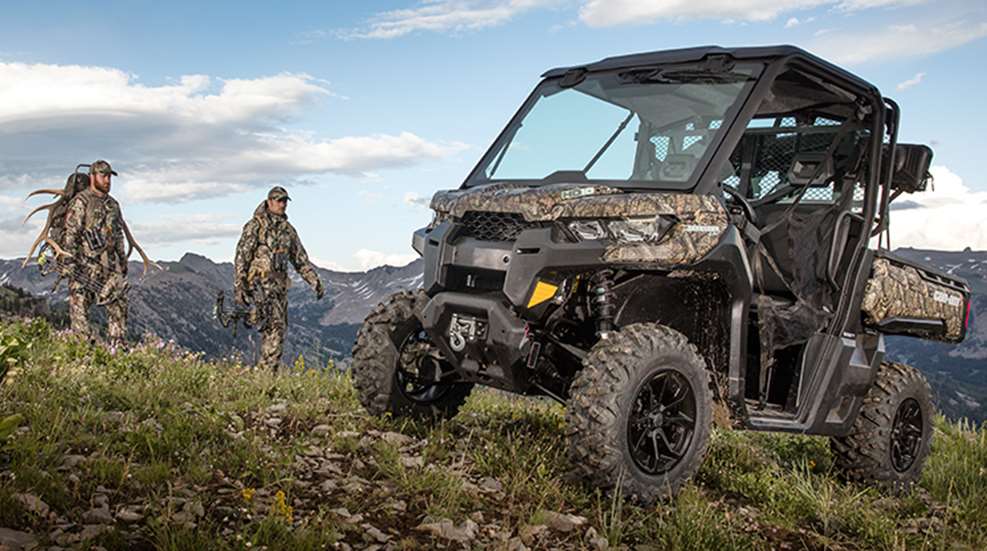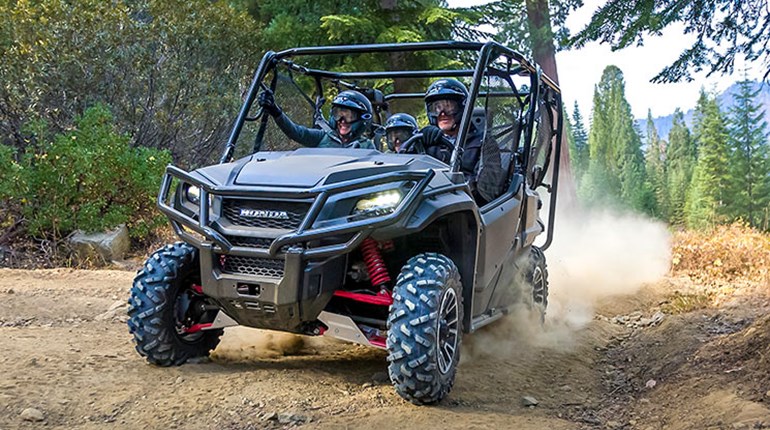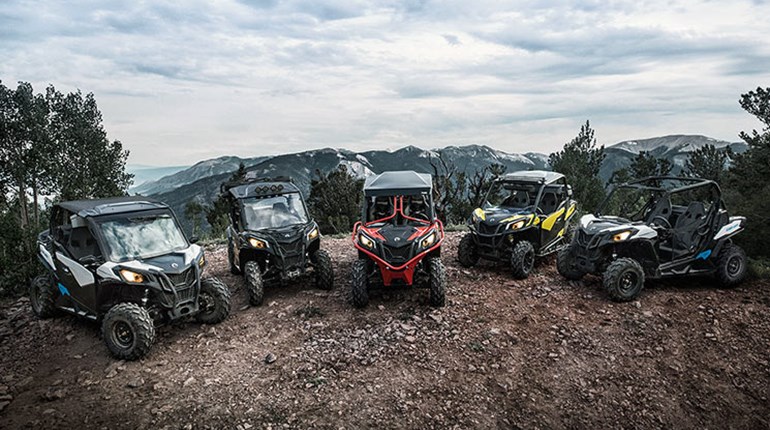
Predicted total 2016 sales industry-wide for new side-by-sides is forecast at 145,000 units. With this slice of the OHV market burgeoning, Can-Am has introduced its second new model for 2016, the Defender (the first being the Commander Max DPR 800). Can-Am says new models will follow every six months over the next four years. The Defender, on sale now, is available in two models: the HD8 799.9cc V-twin and HD10 976cc V-twin; both are fuel-injected and liquid-cooled.
The Commander falls in the “rec-ute” side-by-side vehicle (SSV) category, where 70 percent of the time the operator enjoys the recreational aspect of SSVs, and 30 percent of the time relies on its utility. The Defender falls into the “utility-rec” SSV segment where the reverse is true.
The Defender platform features a fully welded, high-strength, low-alloy grade steel frame with a spine that runs fore and aft down the center. It extrudes in the front to provide bumper function, while the rear of the spine can host an optional 2-inch receiver hitch. The floor is a high-strength composite material; the base model is equipped with composite plates that protect the engine and transmission. Optional full-underbody, high-strength 3/16-inch aluminum skid plates are available. The exterior features dual-protection anti-corrosion coating.
The rear suspension is a TTA-HD setup (torsional trailing arm, heavy-duty) for reduced camber changes, with two coil-over shocks with adjustable preload. Up front is a double A-arm setup with five-way preload adjustable shocks. Suspension travel is 10 inches. Ground clearance is 11 inches. Wheel choices are 12 and 14 inches.
Located at the rear of the unit directly below the cargo bed, the engine delivers torque (as 4WD is needed) to the front wheels via a transfer case. The front wheels feature auto differential lock with rear wheel differential lock being a selection the driver makes by touching a dash-mounted toggle switch. This provides a turf-type mode that prevents a lawn from being disturbed when driving on it. Turning radius is 26 feet. Other dash selections the driver has via toggle switches are 2WD or 4WD.
The only difference between the HD8 and HD10 Defender is engine displacement. The Rotax engine in the HD8 yields 50 hp and 50 lb.-ft. of torque, while the HD10 Rotax engine develops 72 hp and 61 lb.-ft. torque. Everything else is identical, including the Pro-Torq CVT transmission that features Can-Am’s Quick Response System, extra low gear, electronic belt protection, hill descent control (engine braking) and a gear-on-gear differential. Both units provide the same hauling and towing capacities; the three-passenger bench seat cab can carry 500 pounds of passengers (or cargo). The cargo bed’s maximum load is 1,000 pounds. The towing capacity for both engines is 2,000 pounds.
The cargo bed measures 38x54.5x12 inches (about a 104-gallon volume of storage) and is lined with a rugged composite material. Four steel anchor points allow cargo to be lashed inside. Slots are fabricated in its walls and floor to receive optional composite separators to compartmentalize the bed. When folded down, the tailgate can hold 250 pounds. It can be quickly removed or returned to service. The cargo bed features release handles (each side aft of the B-pillars) that when released permit the bed to be tilted to dump cargo (firewood, food plot supplies, etc.). This function can be augmented with an optional electric power assist. When the bed is tilted, owners have unobstructed access to service and maintain the engine and transmission, and to check fluid levels and fill fluid reservoirs. If greater access is needed, the gas strut can be quickly detached, permitting the cargo bed to be articulated to an almost vertical position. It can be reattached just as quickly. The 10.6-gallon fuel tank fill is located just aft of the passenger ingress, below the B-pillar.
A small front hood houses the remaining fluid reservoirs. This is where the owner inserts the security key, which dictates use of the Defender, or whether it can be used at all. Can-Am’s dual-encoded security system comes with three keys; work, standard and performance. Once the security key of choice is inserted, the dash-mounted ignition key becomes operational.
The Defender makes a giant leap forward in cab design. The A-pillars are located forward and positioned at a 25-degree angle to improve visibility and permit easy ingress/egress. The forward outer corners of the driver and passenger seats are angled, eliminating the conventional 90-degree design often associated with SSV seats to improve ingress/egress and reduce wear and tear on seat fabric that can occur when occupants slide on or off the seat. The bench seat is dressed with a rugged vinyl fabric that resists damage from a dog’s nails.
The passenger bench seat folds up, and when it’s out of the way additional cargo storage becomes available. A fold-down arm rest/cup holder can be lowered from its vertical (storage) position when a third passenger is not aboard. Below the outboard passenger seat is a composite 6-gallon waterproof removable cargo bin. The driver’s seat is adjustable fore and aft, and the steering wheel telescopes. The shifter (park, reverse, neutral, high, low) is dash-mounted just to the right of the steering wheel. This permits the driver (with the wheel tilted forward) to change the gear shifter selection simply by turning his wrist if his forearm is resting on the steering wheel.
Total cab storage volume is 16.2 gallons. Also there is a fold-down, dash-mounted pocket compartment to the left of the steering wheel, and open storage below the dash on the passenger side. The toggle switch that operates an optional winch is dash-mounted to the left of the steering wheel. This location permits the driver to step out of the cab and operate the winch from afar. The 2/4WD and rear diff-lock switches are located on the dash to the right of the steering wheel. Can-Am includes a removable composite water-resistant glove box (fitted with a handle) that clips into a slot on the dash on the passenger side. It can be removed from the dash for loading gear and then reinstalled. This provides the operator with several removable glove boxes that can be used as carriers to meet changing jobs/needs (tools, ag or hunting gear). A passenger grab handle is positioned within reach of both occupants.
Defender electrics include a deep-cycle chassis battery, 12-volt power port for charging electronic devices and a 650-watt magneto. The headlight setup includes four 35-watt LED lamps (two on each side up front). A port for the optional winch remote control is located under the hood.
Can-Am accessories include: snowplows; winches; snow-tracks that turn the Defender into a snow-cat; heaters; bumpers; skid plates; a quick-install windshield; rear cab screen/window; soft and hard cab enclosures; front and rear exterior LED lights; solid roofs; and foldable cargo bed wall extenders. Four Defender units are available in five exterior colors. The base model Defender HD8 MSRP is $10,999. The Defender HD10 XT CAB in Mossy Oak Break-Up Country camo has an MSRP of $23,849.
Technical Specifications:
• Drivetrain: 799.9cc Rotax V-twin engine with 50 hp, 50 lb.-ft. torque; Pro-Torq CVT transmission; selectable 4WD with Visco-Lok, auto-locking differential; electronic hill descent control
• Suspension: front double A-arms, twin-tube gas-charged shocks, 10” travel; rear torsional trailing A-arms w/external sway bar, twin-tube gas-charged shocks, 10" travel
• Brakes: front/rear 220mm ventilated discs w/hydraulic twin-piston calipers
• Dimensions/Capacities: overall length 120"; width 62"; height 76"; wheelbase 83"; ground clearance 11"; dry weight 1,395 lbs.; towing capacity 2,000 lbs.; payload 1,500 lbs.; fuel capacity 10.6 gals.
• MSRP: $10,999




































